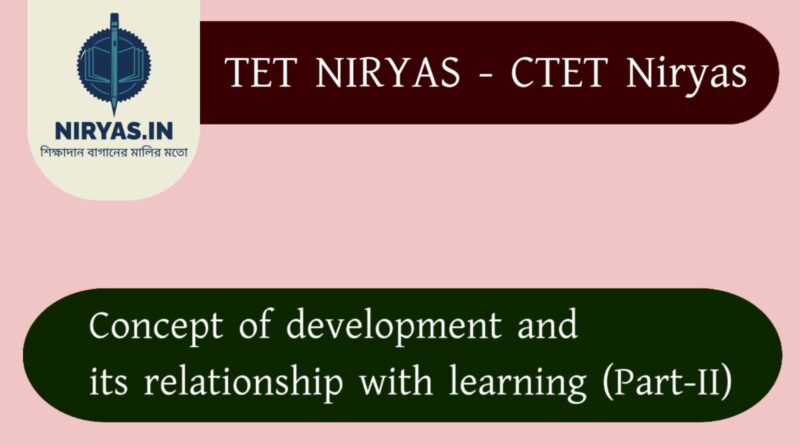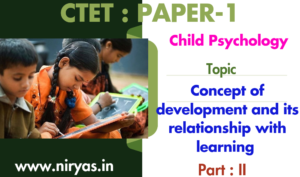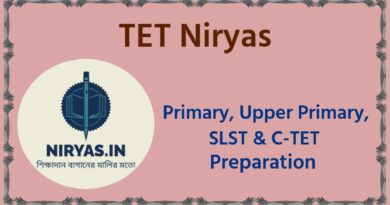Concept of Learning : Concept of development and its relationship with learning Part-II
Concept of Learning : Concept of development and its relationship with learning Part-II
CTET is a central government-run examination system, where the exam is conducted for Paper-I and Paper-II. Candidates who pass Paper-I are considered eligible to teach in Primary Schools and those who pass Paper-II are considered eligible to teach in Upper Primary Schools. Candidates with CTET pass certificate can apply for teaching jobs in KVs, NVs, ERDO and National Army schools. Many private schools in India also select candidates on the basis of CTET score. At present, if you have passed CTET, you can also apply for teaching jobs in schools in different states, in this case, it is not necessary to pass the TET conducted by the state government. This current post discusses the topic Concept of Learning; Concept of development and its relationship with learning Part-II of Child Psychology included in the CTET Paper-I syllabus. The entire topic will be completed in several parts, so click Next to read the Next Part:
III. Concept of Learning :
➲ Concept of Learning : Learning is a fundamental aspect of human development, enabling individuals to acquire new knowledge, skills, and attitudes that facilitate adaptation, problem-solving, and personal growth. In this section, we will explore the concept of learning, including its definition, types, and factors that influence it.
➲ History and Timeline of Concept of Learning : The concept of learning has a rich and diverse history that spans thousands of years. Here is a brief timeline of the major milestones in the history of the concept of learning:
✧ Ancient Civilizations (3000 BCE – 500 CE) :
➥ Ancient Greeks: Philosophers such as Plato and Aristotle discussed the concept of learning and its relationship to knowledge and wisdom.
➥ Ancient Romans: Educators such as Quintilian and Cicero wrote about the importance of education and learning.
✧ Middle Ages (500 – 1500 CE) :
➥ Scholasticism: Theologians and philosophers such as Thomas Aquinas and William of Ockham developed the concept of learning as a process of acquiring knowledge and understanding.
✧ Renaissance and Enlightenment (1500 – 1800 CE) :
➥ Humanism: Educators such as Erasmus and Montaigne emphasized the importance of individualism and self-directed learning.
➥ Empiricism: Philosophers such as John Locke and David Hume developed the concept of learning as a process of acquiring knowledge through experience and observation.
✧ 19th and 20th Centuries (1800 – 2000 CE) :
➥ Behavioral Psychology: Psychologists such as John B. Watson and B.F. Skinner developed the concept of learning as a process of conditioning and reinforcement.
➥ Cognitive Psychology: Psychologists such as Jean Piaget and Ulric Neisser developed the concept of learning as a process of cognitive development and information processing.
➥ Social Learning Theory: Psychologists such as Albert Bandura and Julian Rotter developed the concept of learning as a process of observing and imitating others.
✧ 21st Century (2000 CE – present) :
➥ Neuroscience: The study of the brain and nervous system has led to a greater understanding of the neural mechanisms underlying learning.
➥ Technology-Enhanced Learning: The widespread use of technology has led to new opportunities and challenges for learning, including online learning, mobile learning, and gamification.
➲ Definition of Learning : Learning is a complex and multifaceted process that involves the acquisition of knowledge, skills, and attitudes. It is a lifelong process that enables individuals to adapt to changing environments, situations, and cultures. Learning can be defined as:
❖ “The process of acquiring new knowledge, skills, and attitudes through experience, study, and practice.” (Merriam-Webster Dictionary)
❖ “A relatively permanent change in behavior or knowledge that results from experience.” (Ormrod, 2012)
➥ Here are the definitions of learning by psychologists :
1. John B. Watson : “Learning is the process of establishing new habits or new responses to stimuli.” (Watson, 1913)
2. B.F. Skinner : “Learning is the process of acquiring new behaviors through reinforcement and conditioning.” (Skinner, 1953)
3. Jean Piaget : “Learning is the process of constructing new knowledge and understanding through active engagement with the environment.” (Piaget, 1954)
4. Albert Bandura : “Learning is the process of acquiring new behaviors and knowledge through observation, imitation, and reinforcement.” (Bandura, 1977)
5. Lev Vygotsky : “Learning is the process of constructing new knowledge and understanding through social interaction and collaboration.” (Vygotsky, 1978)
6. Edward Thorndike : “Learning is the process of acquiring new connections between stimuli and responses.” (Thorndike, 1913)
7. Clark Hull : “Learning is the process of acquiring new habits through the association of stimuli and responses.” (Hull, 1943)
➲ Key Characteristics of Learning : Here’s a detailed explanation of the key characteristics of learning with examples:
❖ Active Engagement: Learning involves active engagement with the environment, including physical and mental activities. This means that learners are not just passive recipients of information, but rather they are actively involved in the learning process through hands-on activities, discussions, and problem-solving.
➥ Example: A student is learning to play a musical instrument. They are actively engaged in the learning process by practicing the instrument, receiving feedback from their teacher, and experimenting with different techniques.
❖ Experience-Based: Learning is based on experience, including direct experience, observation, and experimentation. This means that learners learn best through direct experience and hands-on activities, rather than just through lectures or reading.
➥ Example: A child is learning to ride a bike. They start by observing others ride, then they practice riding with training wheels, and finally they experiment with riding without training wheels.
❖ Permanent Change: Learning results in a relatively permanent change in behavior or knowledge. This means that learning is not just a temporary change, but rather it leads to a long-term change in the learner’s behavior, knowledge, or attitudes.
➥ Example: A person learns to speak a new language. After months of practice and study, they are able to communicate fluently and confidently in the new language, and this skill remains with them for the rest of their life.
❖ Constructive Process: Learning is a constructive process, where individuals actively construct new knowledge and understanding. This means that learners are not just passive recipients of information, but rather they are actively involved in constructing their own knowledge and understanding.
➥ Example: A student is learning about a new scientific concept. They start by reading about the concept, then they discuss it with their classmates, and finally they create a project that demonstrates their understanding of the concept.
❖ Context-Dependent: Learning is context-dependent, meaning that it is influenced by the social, cultural, and physical environment. This means that the learning process is influenced by the learner’s background, culture, and environment, and that learning is more effective when it is relevant and meaningful to the learner’s context.
➥ Example: A person is learning a new skill for work. They are more likely to learn the skill if they are in a supportive work environment with opportunities for practice and feedback, rather than if they are trying to learn the skill on their own without any support.
প্রাথমিক টেট প্রস্তুতির জন্য ক্লিক করুনঃ
উচ্চ প্রাথমিক টেট প্রস্তুতির জন্য ক্লিক করুনঃ
➲ Implications for Practice : Understanding the concept of learning has significant implications for practice, including:
❖ Designing Effective Learning Environments: Creating learning environments that support active engagement, experience-based learning, and constructive processes is crucial for effective learning. This can be achieved by:
◈ Incorporating hands-on activities and experiments
◈ Providing opportunities for learners to work in groups and collaborate
◈ Using technology to support interactive and immersive learning experiences
◈ Creating a safe and supportive learning environment that encourages learners to take risks and try new things
➥ Example: A teacher creates a science lab where students can conduct experiments and investigations to learn about scientific concepts. The lab is designed to promote active engagement, collaboration, and hands-on learning.
❖ Using Evidence-Based Instructional Strategies: Using instructional strategies that are grounded in research and theory is essential for effective teaching and learning. This can be achieved by:
◈ Using behavioral theories to design instructional strategies that promote positive reinforcement and motivation
◈ Using cognitive theories to design instructional strategies that promote deep learning and understanding
◈ Using social learning theories to design instructional strategies that promote social interaction and collaboration
➥ Example: A teacher uses a behavioral theory-based instructional strategy to promote positive reinforcement and motivation in the classroom. The teacher provides clear instructions, sets achievable goals, and provides feedback and rewards to students who meet the goals.
❖ Fostering a Growth Mindset: Encouraging learners to view challenges as opportunities for growth and development, rather than threats to their ego, is essential for promoting a growth mindset. This can be achieved by:
◈ Emphasizing effort and progress rather than ability or talent
◈ Providing feedback that is focused on specific behaviors or actions rather than general traits or characteristics
◈ Encouraging learners to take risks and try new things
◈ Providing opportunities for learners to reflect on their learning and set goals for themselves
➥ Example: A teacher encourages students to view challenges as opportunities for growth and development by emphasizing effort and progress rather than ability or talent. The teacher provides feedback that is focused on specific behaviors or actions, and encourages students to take risks and try new things.
By understanding the concept of learning, educators, policymakers, and practitioners can design and implement effective learning environments and instructional strategies that support optimal learning and development.
➲ Types of Learning : There are several types of learning, including:
☉ Formal Learning : Formal learning occurs in structured educational settings, such as schools, universities, and training programs. It is typically characterized by a set curriculum, instructor-led instruction, and assessment of learning outcomes.
➥ Examples: classroom instruction, online courses, workshops, and conferences
☉ Informal Learning : Informal learning occurs outside of formal educational settings, such as through personal experiences, social interactions, and self-directed learning. It is often unplanned and unstructured, but can be just as effective as formal learning.
➥ Examples: learning from experience, learning from others, self-directed learning, and online tutorials
☉ Experiential Learning : Experiential learning occurs through direct experience and hands-on activity. It involves learning by doing, rather than just listening or reading. Experiential learning can be formal or informal, and is often used in fields such as education, business, and healthcare.
➥ Examples: internships, apprenticeships, project-based learning, and service-learning
☉ Self-Directed Learning : A type of learning where individuals take responsibility for their own learning. Its involves setting goals, identifying resources, and evaluating progress. It can be formal or informal, and is often used in fields such as education, business, and healthcare.
➥ Examples: online courses, self-paced learning, and personal projects
☉ Social Learning : A type of learning that occurs through observing and imitating others. It often occurs in social situations, such as in the workplace or in social groups. It can be formal or informal, and is often used in fields such as education, business, and healthcare
➥ Examples: learning from a mentor, learning from a role model, and learning through social media
☉ Online Learning : A type of learning that occurs through digital platforms, such as online courses, webinars, and virtual classrooms. It can be formal or informal, and is often used in fields such as education, business, and healthcare.
➥ Examples: massive open online courses (MOOCs), online degree programs, and online training programs
☉ Blended Learning : A type of learning that combines formal and informal learning, often using a combination of online and offline methods. It can be used in fields such as education, business, and healthcare.
➥ Examples: flipped classrooms, hybrid courses, and blended online and offline training programs
➲ Factors Influencing Learning : Several factors influence learning, including:
☉ Motivation : Motivation is a critical factor in learning, as it drives individuals to engage with learning materials and activities. Intrinsic motivation, which arises from personal interest and enjoyment, is particularly effective in promoting learning.
➥ Types of motivation:
◈ Intrinsic motivation (personal interest and enjoyment)
◈ Extrinsic motivation (rewards, grades, and external pressures)
◈ Self-determination theory (autonomy, competence, and relatedness)
☉ Engagement : Engagement refers to the level of participation and involvement in learning activities. High levels of engagement are associated with better learning outcomes and increased motivation.
➥ Types of engagement:
◈ Behavioral engagement (participation, attendance, and effort)
◈ Emotional engagement (enjoyment, interest, and satisfaction)
◈ Cognitive engagement (thinking, problem-solving, and reflection)
☉ Context : Context refers to the social, cultural, and environmental factors that surround learning. Context can either facilitate or hinder learning, depending on whether it provides a supportive and inclusive environment.
➥ Types of context:
◈ Social context (peers, family, and community)
◈ Cultural context (values, norms, and practices)
◈ Environmental context (physical and technological environment)
☉ Prior Knowledge and Experience : Prior knowledge and experience can influence learning by providing a foundation for new information and skills.
➥ Types of prior knowledge and experience:
◈ Formal education (schooling and training)
◈ Informal education (experiences and self-directed learning)
◈ Life experiences (work, travel, and personal experiences)
☉ Learning Style and Preferences : Learning style and preferences, such as visual, auditory, or kinesthetic learning, can influence learning by affecting the way individuals process and retain information.
➥ Types of learning styles and preferences:
◈ Visual learning (images, diagrams, and videos)
◈ Auditory learning (lectures, discussions, and audio recordings)
◈ Kinesthetic learning (hands-on activities, experiments, and simulations)
☉ Emotional and Social Factors : Emotional and social factors, such as anxiety, stress, and social support, can influence learning by affecting motivation, engagement, and overall well-being.
➥ Types of emotional and social factors:
◈ Emotional factors (anxiety, stress, motivation, and self-esteem)
◈ Social factors (social support, peer relationships, and teacher-student relationships)
These factors interact and influence one another, shaping the learning process and outcomes. Understanding these factors can help educators, policymakers, and learners themselves to design and implement effective learning strategies and environments.
➲ Theories of Learning : Several theories of learning attempt to explain the complex process of learning, including:
❖ Behavioral Theory : Behavioral theory posits that learning occurs through observable behaviors and reinforcement.
⦿ Key concepts:
◈ Classical conditioning (associative learning)
◈ Operant conditioning (reinforcement and punishment)
◈ Behavior modification (changing behavior through reinforcement and punishment)
⦾ Theorists:
◈ Ivan Pavlov (classical conditioning)
◈ B.F. Skinner (operant conditioning)
◈ John B. Watson (behavioral psychology)
❖ Cognitive Theory : Cognitive theory posits that learning occurs through mental processes, such as perception, attention, and memory.
⦿ Key concepts:
◈ Information processing (encoding, storage, and retrieval of information)
◈ Cognitive structures (schemas, frameworks, and mental models)
◈ Cognitive processes (perception, attention, memory, and problem-solving)
⦾ Theorists:
◈ Ulric Neisser (cognitive psychology)
◈ Jerome Bruner (cognitive development)
◈ Jean Piaget (cognitive development)
❖ Social Cognitive Theory : Social cognitive theory posits that learning occurs through observing and imitating others.
⦿ Key concepts:
◈ Observational learning (learning by observing others)
◈ Modeling (imitating others)
◈ Self-efficacy (confidence in one’s ability to perform a task)
⦾ Theorists:
◈ Albert Bandura (social cognitive theory)
◈ Julian Rotter (social learning theory)
❖ Constructivist Theory : Constructivist theory posits that learning occurs through active construction of knowledge and meaning.
⦿ Key concepts:
◈ Active learning (learners actively construct knowledge)
◈ Constructing meaning (learners create their own understanding)
◈ Social constructivism (learning is a social process)
⦾ Theorists:
◈ Jean Piaget (constructivist theory)
◈ Lev Vygotsky (social constructivist theory)
◈ Jerome Bruner (constructivist theory)
These theories of learning provide a framework for understanding the complex process of learning and for designing effective instructional strategies.
➲ Implications for Practice : Understanding the concept of learning and the factors that influence it has significant implications for practice, including:
❖ Instructional Design : Instructional design should take into account the various factors that influence learning, such as motivation, engagement, and context.
❖ Teaching Methods : Teaching methods should be tailored to individual learning styles and preferences, and should incorporate active learning strategies to promote engagement and motivation.
❖ Assessment and Evaluation : Assessment and evaluation should be designed to measure learning outcomes and provide feedback to learners, rather than simply measuring knowledge retention.
❖ Learning Environment : The learning environment should be designed to promote motivation, engagement, and social interaction, and should provide opportunities for learners to take ownership of their learning. Download : Paper-I CDP eBook
➲ Conclusion : In conclusion, learning is a complex and multifaceted process that is influenced by a range of factors, including motivation, engagement, context, and prior knowledge and experience. Understanding these factors and how they interact is crucial for promoting effective learning and improving educational outcomes. ➣ Next Part


